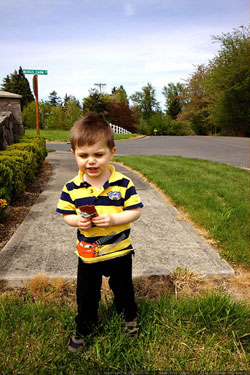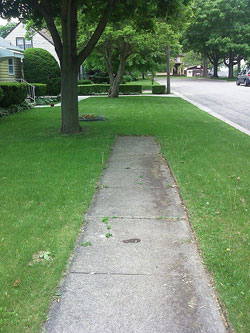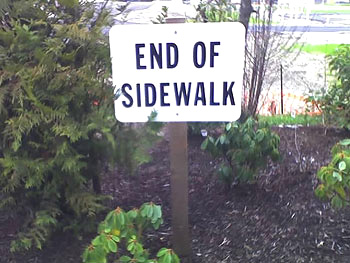Almost everyone has heard of the poem “Where the Sidewalk Ends” by Shel Silverstein. It is a poem that many enjoyed during childhood. Let’s read it again.

Source: where the sidewalk ends - eating fruit leather -
_MG_3250, sean dreilinger, Flickr
Where the Sidewalk Ends
There is a place where the sidewalk ends
And before the street begins,
And there the grass grows soft and white,
And there the sun burns crimson bright,
And there the moon-bird rests from his flight
To cool in the peppermint wind.
Let us leave this place where the smoke blows black
And the dark street winds and bends.
Past the pits where the asphalt flowers grow
We shall walk with a walk that is measured and slow,
And watch where the chalk-white arrows go
To the place where the sidewalk ends.
Yes we’ll walk with a walk that is measured and slow,
And we’ll go where the chalk-white arrows go,
For the children, they mark, and the children, they know
The place where the sidewalk ends.
On the surface, this poem seems like a pleasant childhood dream, but if we look at it again more carefully, we can see examples of imagery, metaphor, and symbolism. Finding these things makes your reading of the poem even richer than before.
Read the poem again and click on the words that Silverstein uses to create images in the reader’s mind.
If you choose correctly, eleven phrases will highlight.


Source: Where the Sidewalk Ends, slworking2, Flickr
There is a place where the sidewalk ends
And before the street begins,
And there the grass grows soft and white,
And there the sun burns crimson bright,
And there the moon-bird rests from his flight
To cool in the peppermint wind.
Let us leave this place where the smoke blows black
And the dark street winds and bends.
Past the pits where the asphalt flowers grow
We shall walk with a walk that is measured and slow,
And watch where the chalk-white arrows go
To the place where the sidewalk ends.
Yes we’ll walk with a walk that is measured and slow,
And we’ll go where the chalk-white arrows go,
For the children, they mark, and the children, they know
The place where the sidewalk ends.
Most of the images used by the poet are things that you can “see” as you read. The one exception is the “peppermint wind,” which is something that must be felt and perhaps smelled.
 Now, let’s take a look at examples of metaphor. Using your notes, answer the following questions. When you are finished, check your understanding to see possible responses.
Now, let’s take a look at examples of metaphor. Using your notes, answer the following questions. When you are finished, check your understanding to see possible responses. - In the second stanza, when the speaker describes “the place where the smoke blows black,” what could he be referring to? Where is a place with black smoke?
- The speaker goes on to describe the “dark street” that “winds and bends.” Many people believe that the street represents the future. Explain Silverstein’s use of this metaphor.
Sample Responses:
- The speaker is referencing a place where there is pollution and smog, possibly a big city.
- Silverstein is saying that unless we change our industrialized ways, our future will be dark and grim.

Source: Where the sidewalk ends, Don Nunn, Flickr
Now, let’s tackle the symbolism of the poem. The poem mentions the children who live their lives on the “sidewalk.” The speaker invites the audience and the children to “walk with a walk that is measured and slow” to the place “where the sidewalk ends.” Knowing these details might lead you to believe that the sidewalk represents a path for escape from the city or perhaps reality, or the sidewalk could represent a journey back to youth and back to imagination. Another interpretation of the ending of the sidewalk might be that it represents the end of childhood and the entrance into the adult world.
Even the simplest of poems can have a deeper meaning, and while we can enjoy a poem for its simplicity, it becomes even richer once we dig beneath the surface and understand what the poet really wants us to see. Doing the exercises in this lesson will help you comprehend the poet’s meaning by giving you practice in finding imagery, metaphors, symbolism, and allusions.